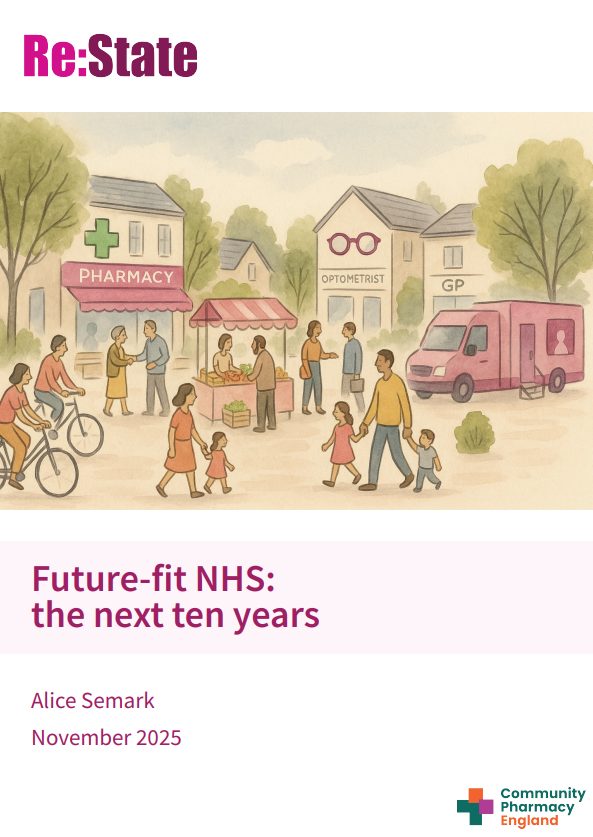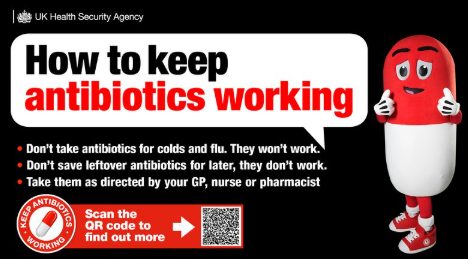Discharge Medicines Service
Published on: 24th February 2020 | Updated on: 7th July 2025
The Discharge Medicines Service (DMS) became a new Essential service within the Community Pharmacy Contractual Framework (CPCF) on 15th February 2021.
This service, which all pharmacy owners have to provide, was originally trialled in the 5-year CPCF agreement, with a formal announcement regarding the service made by the Secretary of State for Health and Social Care in February 2020.
From 15th February 2021, NHS Trusts were able to refer patients who would benefit from extra guidance around prescribed medicines for provision of the DMS at their community pharmacy. The service has been identified by NHS England’s Medicines Safety Improvement Programme to be a significant contributor to the safety of patients at transitions of care, by reducing readmissions to hospital.
Latest update
The new streamlined process for making claims for the Discharge Medicines Service (DMS) is now live.
The new process, which has been agreed following feedback about the previous lengthy process from Community Pharmacy England, should be used to claim for any activity for DMS that has been completed since 1st July 2025. It should also be used for DMS data of activity started on or before 30th June 2025 but not completed.
Read the news story on the new shortened claim journey for DMS
Click on a heading below for more information
This service builds on the work that the Academic Health Science Networks (AHSN) undertook with LPCs and pharmacy owners over recent years, as part of the Transfer of Care Around Medicines (TCAM) programme.
Within this programme, the AHSNs worked with NHS hospitals to put in place processes and IT infrastructure to allow hospital clinicians to identify patients admitted to hospital that might benefit from being referred to their community pharmacy at discharge. Over half of English hospitals have already participated in the programme and consequently many community pharmacies received information on their patients’ medicines regimen at discharge from hospital prior to the start of the DMS.
The need and evidence base for the service
Discharge from hospital is associated with an increased risk of avoidable medication related harm and NICE Guideline NG5 includes the following recommendations:
- Medicines-related communication systems should be in place when patients move from one care setting to another; and
- Medicines reconciliation processes should be in place for all persons discharged from a hospital or another care setting back into primary care and the act of reconciling the medicines should happen within a week of the patient being discharged.
Implementation of these recommendations requires pharmacy professionals and their teams across NHS Trusts, Primary Care Networks (PCN) and community pharmacies to work together much more effectively.
A recent audit of NHS hospital discharges showed that 79% of patients were prescribed at least one new medication after being discharged from hospital. New prescriptions can sometimes cause side effects, or interact with existing treatments, potentially leading to readmission.
Research by the National Institute for Health Research shows that people over 65 are less likely to be readmitted to hospital if they are given help with their medication after discharge. Research on local schemes implemented around the country has also demonstrated that patients who see their community pharmacist after they have been in hospital are less likely to be readmitted and will experience a shorter stay if they are.
The aims of the service
The service seeks to ensure better communication of changes made to a patient’s medicines in hospital and its aims are to:
- Optimise the use of medicines, whilst facilitating shared decision making;
- Reduce harm from medicines at transfers of care;
- Improve patients’ understanding of their medicines and how to take them following discharge from hospital;
- Reduce hospital readmissions; and
- Support the development of effective team-working across hospital, community and primary care networks pharmacy teams and general practice teams and provide clarity about respective roles.
On 20th October 2020 new NHS regulations were laid to introduce changes to the Terms of Service for pharmacy owners and these included the contractual requirements for the DMS. Further information and guidance on the service was published by NHS England in guidance on the regulations and in the DMS Toolkit for pharmacy staff in community, primary and secondary care.
NHS England guidance on the regulations
DMS Toolkit for pharmacy staff in community, primary and secondary care
Patients are digitally referred to their pharmacy after discharge from hospital, using IT systems or NHSmail. Using the information in the referral, pharmacists are able to compare the patient’s medicines at discharge to those they were taking before admission to hospital. A check is also made when the first new prescription for the patient is issued in primary care and a consultation with the patient and/or their carer will help to ensure that they understand which medicines the patient should now be using.
Staff training and competence
Pharmacy owners need to ensure relevant staff, including pharmacists and pharmacy technicians, who will be involved in providing the service, have the necessary knowledge and competence to undertake it safely. As a minimum, pharmacists and pharmacy technicians who will provide the service should:
- Read the section on DMS within the NHS England guidance on the regulations; and
- Read the DMS toolkit.
Additionally, it is recommended that they also complete the CPPE NHS Discharge Medicines Service eLearning and assessment.
Once a pharmacist or pharmacy technician has undertaken appropriate learning related to the service, they must complete the DMS Declaration of Competence and provide a copy of that to the pharmacy owner.
Other members of staff that will play a part in supporting provision of the service should be briefed on the service, with appropriate training provided for any roles they will play. The following document can be used in briefing sessions for pharmacy team members.
DMS briefing for pharmacy teams
Standard Operating Procedure
Pharmacy owners must have a Standard Operating Procedure (SOP) for the service, which all staff participating in provision of the service must be familiar with and follow.
The SOP should include the process for checking, on a regular basis, for new DMS referrals.
Pharmacy owner checklist
Pharmacy owners need to undertake the following actions in preparation for providing the service:
- Read the NHS England regulations guidance and the NHS England DMS toolkit, so that you understand the service requirements;
- Ensure any pharmacists or pharmacy technicians (including locums) that will be undertaking the service also read both those documents. Encourage them to also undertake the CPPE DMS e-learning and assessment;
- Find out which Trusts in your area are already making referrals to community pharmacies following patients’ discharge and which will be starting this in due course. Your LPC or local NHS contract management team will be able to provide this information to you. If it is likely that referrals will not start to be received soon after the service commences, pharmacy owners may need to refresh the knowledge of staff regarding the service once referrals do commence;
- Consider the practicalities of providing the service, including the conversation with the patient and /or their carer in stage 3 and how you will be able to undertake that remotely, where the patient cannot visit the pharmacy. Also think about your referral networks to general practices and how clinical pharmacists within your Primary Care Network may be able to assist with issues you have identified with a patient’s medicines regimen;
- Develop a Standard Operating Procedure (SOP) for the service. Make sure this includes the process by which referrals from Trusts will be received, how staff can access these referrals and the regularity of checking for new referrals;
- Ensure all staff that will undertake parts of the service are briefed on the service and their role, and they are familiar with relevant sections of the SOP;
- Once pharmacists and pharmacy technicians have undertaken the activity in point 2 and they are confident that they fully understand the service requirements and how it will operate in the pharmacy, they should complete the DMS Declaration of Competence and provide a copy of the completed document to the pharmacy owner.
NHS Trusts will identify patients who will benefit from DMS and, subject to the patient consenting to a referral, they will send a referral to the pharmacy via a secure electronic system or NHSmail.
The following information should be included, as a minimum, in the referral:
- The demographic and contact details of the person and their registered general practice (including their NHS number and their hospital Medical Record Number);
- The medicines being used by the patient at discharge (including prescribed, over‑the‑counter and specialist medicines, as there may be medicines interactions), including the name, strength, form, dose, timing, frequency and planned duration of treatment for all and the reason for prescribing;
- How the medicines are taken and what they are being taken for;
- Changes to medicines, including medicines started or stopped, or dosage changes, and reason for the change; and
- Contact details for the referring clinician or hospital department, to use where the pharmacy has a query.
Ideally, the referral should also contain the hospital’s Organisation Data Service (ODS) code.
All pharmacy staff involved in providing the service will need to understand how referrals are made and what IT systems to check for referrals.
At the time of commencement of the service, not all NHS Trusts had put in place processes to refer suitable patients to their community pharmacy, so the initial likelihood of pharmacies receiving DMS referrals will vary depending on the local situation.
LPCs have provided information to Community Pharmacy England on whether NHS Trusts/hospitals are currently issuing DMS referrals (live), are considering whether to make referrals or are working towards becoming live (considering) or are not yet live and no consideration has yet been given to making referrals (not yet live). This information and the referral mechanism used by hospitals which are live can be seen in the following document. This is based on the best information available to LPCs.
DMS referral status report (17th June 2022)
LPCs may be able to provide further information on the readiness of individual local trusts to make referrals to the service.
DMS IT funding for Trusts
NHS England has made funding available to Clinical Commissioning Groups (CCGs) so that all acute, community and mental health NHS trusts in England can support IT solutions or software licenses for the NHS Discharge Medicines Service (DMS).
The funding will enable more community pharmacies to receive DMS referrals via a structured, electronic message instead of via the more manual route (e.g. by NHSmail message). This should increase the overall volume of DMS referrals.
NHS Trust IT Support Offer Feb 2022 – FutureNHS Collaboration Platform (Login required)
Appropriate clinical records must be kept by the pharmacy owner, within the patient medication record (PMR) system or other appropriate record, for all stages of the service provided.
Additionally, from the clinical records maintained by the pharmacy owner, summary data on each DMS provided has to be provided as part of the payment claim for the service. This data will support the evaluation of the impact of the service, contract monitoring and post-payment verification.
While maintaining records in an electronic system is the ideal approach, it is possible to provide the service using a combination of annotation of the patient’s PMR and the use of paper records. Community Pharmacy England has developed a DMS worksheet which can be used to maintain clinical records for the service and collate the summary data which has to be provided as part of the payment claim for the service. This worksheet can be used where pharmacy teams do not have access to an IT system to support the creation of electronic clinical records for the service.
DMS worksheet V1 (Microsoft Word)
DMS activity summary
This document summarises the actions to be taken at the three stages of the service.
NHS approved IT systems for recording DMS consultations and sharing data with NHSBSA are due to be ready in the first quarter of 2024.
This development follows negotiations with NHS England and the Department of Health and Social Care where it has previously been agreed that IT support for CPCF clinical services will be updated to allow information on services provided and payment claims to automatically flow from pharmacy IT system to the NHSBSA.
This work has already been completed for several of the CPCS clinical services, with the development of application programming interfaces (API) between pharmacy IT systems and the NHSBSA’s Manage Your Service (MYS) portal.
NHS England have advised that the go-live date for the DMS IT systems is 1st February 2024.
Once the work at the NHSBSA and IT system suppliers is completed, pharmacy owners providing the services will need to use an approved pharmacy clinical IT system to keep their clinical records for the services and to submit data on the provision of the service and payment claims to MYS. At that time, the current manual MYS claim processes for the services will be retired.
Find out more about IT support for all CPCF clinical services
It is expected that all patients referred to the pharmacy will ordinarily receive all three stages of the service. They may be provided sequentially or in parallel, depending on the individual circumstances of the patient.
The following table summarises the three stages of the service.
| Stage | Description of process | Timescale | Responsibility |
| 1) A discharge referral is received by the pharmacy | The electronic referral is received by the pharmacy and the following actions are undertaken: | As soon as possible, but within 72 hours of receipt (excluding hours of the days on which the pharmacy premises are not open for business). Section 8,7 of the NHS England guidance on the regulations provides more information on this timing requirement. | |
| a) Check for clinical information and actions contained within the referral which need to be undertaken. Details of what to look for are outlined in the DMS toolkit; |
Pharmacist
|
||
| b) Compare the medicines the patient has been discharged on and those they were previously taking at admission; | Pharmacist/ Pharmacy technician | ||
| c) Where necessary, raise any issues identified with the NHS Trust or the patient’s general practice, as appropriate; | Pharmacist/ pharmacy technician | ||
| d) Make appropriate notes on the PMR or other appropriate record, including to ensure pharmacy staff are alerted to the need to conduct stages 2 and 3 of the service, when the first prescription is received or at first contact with the patient/carer; and | Pharmacist/ pharmacy technician | ||
| e) Check any prescriptions for the patient, previously ordered, in the dispensing process or awaiting collection to see if they are still appropriate. Particular attention should be paid to electronic repeat dispensing prescriptions as these could be pulled down from the system sometime after the patient has been discharged from hospital. | All relevant members of the pharmacy team | ||
| 2) The first prescription is received by the pharmacy following discharge (this may not be a repeat prescription) |
The pharmacist/pharmacy technician ensure medicines prescribed post-discharge take account of the appropriate changes made during the hospital admission. If there are discrepancies or other issues, the pharmacy team will try to resolve them with the GP practice, utilising existing communication channels. Complex issues may need to be resolved by the general practice undertaking a Structured Medication Review; and Make appropriate notes on the PMR and/or other appropriate record. |
When the first post-discharge prescription is received, usually one week to one-month post-discharge, dependent on the quantity of medicines supplied by the hospital at discharge. | Pharmacist/ Pharmacy Technician |
| 3) Check of the patient’s understanding of their medicines regimen |
This involves a confidential discussion, adopting a shared decision-making approach, with the patient and/or their carer to check their understanding of what medicines they should now be taking/using, when they should be taken/used and any other relevant advice to support medicines taking/use. When this takes place on the pharmacy premises, the consultation room should be used*. Where the patient and/or their carer cannot attend the pharmacy for this discussion, e.g. if they are housebound or convalescing following surgery, this can be provided in a manner which meets the patient’s/carer’s needs, e.g. by telephone or video consultation. Information that would be of value to the patient’s general practice or Primary Care Network clinical pharmacist, to support the ongoing care of the patient, should be communicated appropriately. Where appropriate, there should also be an offer to dispose of any medicines that are no longer required, to avoid potential confusion and prevent an adverse event. Make appropriate notes on the PMR and/or other appropriate record. Where appropriate, other services which form part of the CPCF can also be provided. For example, the New Medicine Service could be offered if clinically appropriate and if the patient would get additional benefit from provision of the service. |
When the first post-discharge prescription is received.
|
Pharmacist/ Pharmacy Technician |
* Distinct from the DMS, all pharmacies must now have a consultation room meeting the set standards. The only exceptions to this are set out in the NHS England regulations guidance. DMS consultations should be undertaken in a consultation room compliant with the requirements or via telephone or video consultation, where those remote options are chosen to meet the need of the patient or because NHS England has agreed the pharmacy is too small for a consultation room to be fitted.
Read more about pharmacy consultation room requirements
The process described above represents the normal flow of patients through the service, however, on occasions this will not be the case and there are circumstances where the pharmacy owner is not able to complete all stages of the service, e.g. when a patient is readmitted to hospital. The NHS England regulations guidance provides more information on potential scenarios when only part of the service can be provided.
DMS activity summary
This document summarises the actions to be taken at the three stages of the service.
A setup fee of £400 was agreed to cover the costs of preparing to provide the service, principally training staff and putting in place a standard operating procedure for the service. Any pharmacy on the pharmaceutical list on 1st February 2021 automatically received this payment on 1st April 2021.
Pharmacy owners providing the full service will be paid a fee of £35.
Where only part of the service can be provided, in certain circumstances defined in the Drug Tariff, pharmacy owners will be paid a partial payment:
Stage 1: £12
Stage 2 £11
Stage 3: £12
Pharmacy owners will make a monthly claim for completed DMS provisions via the NHSBSA’s Manage Your Service (MYS) portal.
The claim for the stages of the DMS completed by the pharmacy owner must be made via the MYS portal no later than the 5th day of the month following that in which the final stage that the pharmacy owner was able to undertake was completed. If the pharmacy owner fails to submit by this deadline, later submissions will be accepted but only if made within three months of the date by which the claim should have been submitted. Later claims will not be paid. Where a pharmacy owner has completed some of the stages of the DMS, but not all the stages of the DMS that they intend to complete, they should not yet make a claim.
Summary data on each DMS provided will have to be provided to support the evaluation of the impact of the service, contract monitoring and post-payment verification.
In time, your pharmacy IT system may support collation of that data** or alternatively, the Community Pharmacy England DMS worksheet (see the resources section below) will also allow you to make clinical records for the service and collate the summary data for submission to the NHSBSA.
** NHS England, NHS Digital and the NHSBSA , supported by Community Pharmacy England, started work with pharmacy IT system suppliers in October 2020 to support the development of an Application Programming Interface (API) which will transfer the DMS summary data from pharmacy IT systems to the NHSBSA’s Manage Your Service portal, so the information does not need to be manually entered into MYS by pharmacy owners.
Answers to frequently asked questions on the DMS can be found on the Discharge Medicines Service FAQ page.
DMS pharmacy owner checklist
This checklist details the actions pharmacy owners need to take to get ready to provide the service.
Briefing sheet: Introduction to the DMS for general practice and PCN clinical pharmacy teams
This two-page briefing provides a short introduction to the service for GPs and clinical pharmacists.
DMS briefing for pharmacy teams
This document can be used in briefings on the DMS provided for pharmacy team members.
Appropriate clinical records must be kept by the pharmacy owner, within the patient medication record (PMR) system or other appropriate record, for all stages of the service provided. While maintaining records in an electronic system is the ideal approach, it is possible to provide the service using a combination of annotation of the patient’s PMR and the use of paper records. Community Pharmacy England has developed a DMS worksheet which can be used to maintain clinical records for the service, which can be used where pharmacy teams do not have access to an IT system to support the creation of electronic clinical records for the service.
DMS worksheet V1 (Microsoft Word)
DMS activity summary
This document summarises the actions to be taken at the three stages of the service.
NHS England guidance on the regulations
DMS Toolkit for pharmacy staff in community, primary and secondary care
DMS data specification – summary data on each DMS provided to be submitted to MYS
DMS launch letter to pharmacy teams from Keith Ridge
DMS launch letter to NHS Trust chief pharmacists from Keith Ridge
Community Pharmacy England clinical service statistics dashboard
The dashboard presents data on the DMS (as well as Advanced services) at three levels (national, LPC and individual pharmacy) for each quarter. The dashboards are based on the NHS Business Services Authority’s (NHSBSA) Discharge Medicines Service data.
NHSBSA Discharge Medicines Service Data
The reports includes pharmacy data with a national running total.
At Community Pharmacy England, we are always keen to hear from pharmacy owners and their teams about how the provision of national pharmacy services is going, be that niggles with the way services are commissioned, a success story you want to share or something else.
Please click on the link below to share a success story where you have helped achieve a good outcome for a patient following a consultation for a national pharmacy service or to provide feedback on one of the services.
For more information on this topic please email services.team@cpe.org.uk











